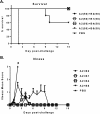A Combination of Three Fully Human Toxin A- and Toxin B-Specific Monoclonal Antibodies Protects against Challenge with Highly Virulent Epidemic Strains of Clostridium difficile in the Hamster Model
- PMID: 25924765
- PMCID: PMC4478530
- DOI: 10.1128/CVI.00763-14
A Combination of Three Fully Human Toxin A- and Toxin B-Specific Monoclonal Antibodies Protects against Challenge with Highly Virulent Epidemic Strains of Clostridium difficile in the Hamster Model
Abstract
Clostridium difficile infection (CDI) is the principal cause of nosocomial diarrhea and pseudomembranous colitis associated with antibiotic therapy. Recent increases in the number of outbreaks attributed to highly virulent antibiotic-resistant strains underscore the importance of identifying efficacious alternatives to antibiotics to control this infection. CDI is mediated by two large exotoxins, toxins A and B. Strong humoral toxin-specific immune responses are associated with recovery and a lack of disease recurrence, whereas insufficient humoral responses are associated with recurrent CDI. Multiple approaches targeting these toxins, including intravenous immunoglobulin, neutralizing polymers, active vaccines, and, most recently, monoclonal antibodies (MAbs), have been explored, with various degrees of success. In this study, we describe the characterization of the first MAbs isolated from healthy human donors using a high-throughput B-cell cloning strategy. The MAbs were selected based on their ability to inhibit the actions of toxins A and B in vitro and because of their in vivo efficacy in a hamster challenge model. A potent 2-MAb cocktail was identified and then further potentiated by the addition of a second anti-toxin B MAb. This 3-MAb combination protected animals against mortality and also reduced the severity and duration of diarrhea associated with challenge with highly virulent strains of C. difficile toxinotypes 0 and III. This highly efficacious cocktail consists of one MAb specific to the receptor binding domain of toxin A and two MAbs specific to nonoverlapping regions of the glucosyltransferase domain of toxin B. This MAb combination offers great potential as a nonantibiotic treatment for the prevention of recurrent CDI.
Copyright © 2015, American Society for Microbiology. All Rights Reserved.
Figures







Similar articles
-
Systemic antibody responses induced by a two-component Clostridium difficile toxoid vaccine protect against C. difficile-associated disease in hamsters.J Med Microbiol. 2013 Sep;62(Pt 9):1394-1404. doi: 10.1099/jmm.0.056796-0. Epub 2013 Mar 21. J Med Microbiol. 2013. PMID: 23518659
-
Human monoclonal antibodies directed against toxins A and B prevent Clostridium difficile-induced mortality in hamsters.Infect Immun. 2006 Nov;74(11):6339-47. doi: 10.1128/IAI.00982-06. Epub 2006 Sep 11. Infect Immun. 2006. PMID: 16966409 Free PMC article.
-
Serum anti-toxin B antibody correlates with protection from recurrent Clostridium difficile infection (CDI).Vaccine. 2010 Jan 22;28(4):965-9. doi: 10.1016/j.vaccine.2009.10.144. Epub 2009 Nov 24. Vaccine. 2010. PMID: 19941990 Clinical Trial.
-
Bezlotoxumab: A Novel Agent for the Prevention of Recurrent Clostridium difficile Infection.Pharmacotherapy. 2017 Oct;37(10):1298-1308. doi: 10.1002/phar.1990. Epub 2017 Sep 12. Pharmacotherapy. 2017. PMID: 28730660 Review.
-
Immune-based treatment and prevention of Clostridium difficile infection.Hum Vaccin Immunother. 2014;10(12):3522-30. doi: 10.4161/21645515.2014.980193. Hum Vaccin Immunother. 2014. PMID: 25668664 Free PMC article. Review.
Cited by
-
Pharmacological Targeting of the Host-Pathogen Interaction: Alternatives to Classical Antibiotics to Combat Drug-Resistant Superbugs.Trends Pharmacol Sci. 2017 May;38(5):473-488. doi: 10.1016/j.tips.2017.02.003. Epub 2017 Mar 8. Trends Pharmacol Sci. 2017. PMID: 28283200 Free PMC article. Review.
-
A probiotic yeast-based immunotherapy against Clostridioides difficile infection.Sci Transl Med. 2020 Oct 28;12(567):eaax4905. doi: 10.1126/scitranslmed.aax4905. Sci Transl Med. 2020. PMID: 33115949 Free PMC article.
-
Chimeric Immunoglobulin and human Immunoglobulin M structures provide insights on joining-chain independent assembly and function.bioRxiv [Preprint]. 2025 Jul 14:2025.07.09.663956. doi: 10.1101/2025.07.09.663956. bioRxiv. 2025. PMID: 40791433 Free PMC article. Preprint.
-
Immunogenicity and Protection from Receptor-Binding Domains of Toxins as Potential Vaccine Candidates for Clostridium difficile.Vaccines (Basel). 2019 Nov 8;7(4):180. doi: 10.3390/vaccines7040180. Vaccines (Basel). 2019. PMID: 31717334 Free PMC article.
-
Epitopes and Mechanism of Action of the Clostridium difficile Toxin A-Neutralizing Antibody Actoxumab.J Mol Biol. 2017 Apr 7;429(7):1030-1044. doi: 10.1016/j.jmb.2017.02.010. Epub 2017 Feb 21. J Mol Biol. 2017. PMID: 28232034 Free PMC article.
References
-
- Lawley TD, Clare S, Deakin LJ, Goulding D, Yen JL, Raisen C, Brandt C, Lovell J, Cooke F, Clark TG, Dougan G. 2010. Use of purified Clostridium difficile spores to facilitate evaluation of health care disinfection regimens. Appl Environ Microbiol 76:6895–6900. doi:10.1128/AEM.00718-10. - DOI - PMC - PubMed
MeSH terms
Substances
LinkOut - more resources
Full Text Sources
Other Literature Sources
Medical
Molecular Biology Databases

